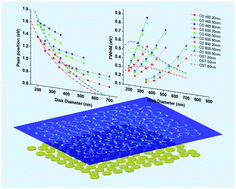Far-field plasmonic coupling in 2-dimensional polycrystalline plasmonic arrays enables wide tunability with low-cost nanofabrication†
Abstract
We report the experimental observation and numerical modeling study of far-field plasmonic coupling (FFPC) in 2-dimensional polycrystalline plasmonic arrays consisting of “single crystalline” domains of a random size and orientation. Even though polycrystalline plasmonic arrays are routine products of low-cost nanosphere lithography (NSL), their FFPC behavior has not been well understood. Herein, FFPC observed from gold nanodisk (AuND) arrays fabricated using NSL appears, qualitatively, to be in keeping with that of highly regular nanoparticle arrays, where they induced cyclic modulations on the peak position and linewidth of the localized surface plasmon resonance (LSPR). Remarkable blue shifts as large as 1000 nm with nearly doubled linewidth were observed experimentally. Numerical modeling was systematically carried out and showed quantitative agreement with the experimental results. Using the modeling approach, the influences of array randomness and particle size on FFPC have been studied independently for the first time. Finally, two potential applications have been developed for FFPC-based LSPR tuning. Firstly, when AuND arrays are fabricated on flexible substrates, a novel transduction mechanism can be established between the LSPR peak position and the substrate strain. Owing to the far-field propagating nature, FFPC-based transduction can effectively extend the strain-tuning displacement range by an order of magnitude compared with those based on near-field coupling. Secondly, we show that FFPC leads to an LSPR peak within 1 μm for nanoporous gold disk arrays, which otherwise have a single particle LSPR peak beyond 1.5 μm. Such a significant FFPC-induced blue shift is critically important for compatibility with the use of silicon-based detectors.



 Please wait while we load your content...
Please wait while we load your content...